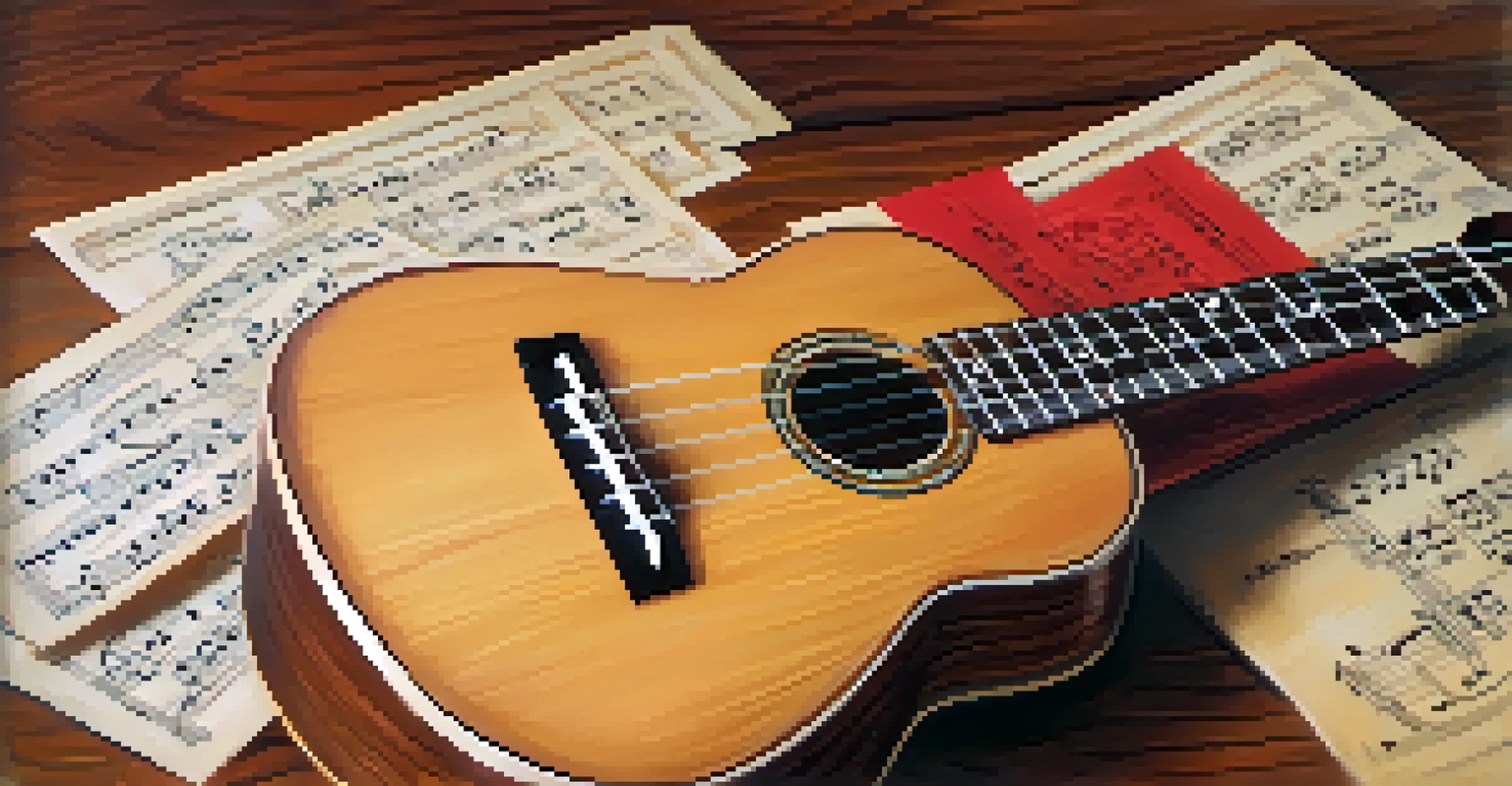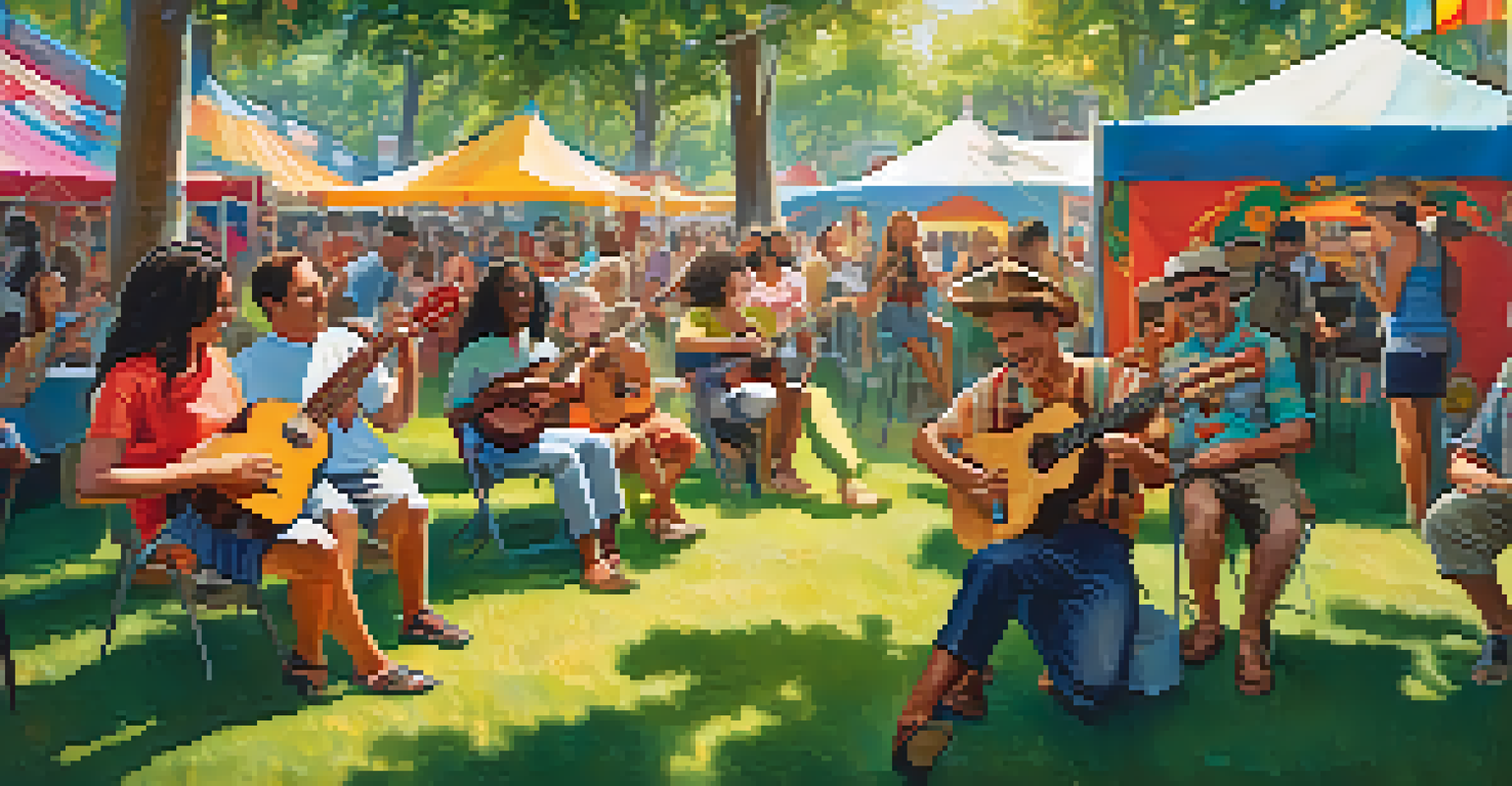Key Historical Ukulele Models and Their Impact on Music

The Birth of the Ukulele: Early Hawaiian Models
The ukulele originated in the 19th century in Hawaii, evolving from the Portuguese braguinha. This early model featured a small body and four nylon strings, creating a distinctive sound that resonated with Hawaiian culture. It quickly became a staple in Hawaiian music, representing the island's spirit and joy.
The ukulele is the perfect instrument for anyone who wants to play music and have fun at the same time.
As the ukulele gained popularity, its design began to adapt, leading to various models that enhanced its sound and playability. Notable early models included the soprano ukulele, which became the most recognized version due to its bright, cheerful tones. The simplicity of these early instruments made them accessible to both musicians and casual players alike.
The influence of these early Hawaiian models extended beyond the islands, capturing the hearts of musicians across the globe. By the early 20th century, the ukulele was featured in vaudeville shows and popular music, helping to establish its place in American culture. This transition marked the beginning of the ukulele's journey into mainstream music.
The Rise of the Martin Ukulele: Quality and Craftsmanship
In the early 1900s, C.F. Martin & Co. began producing ukuleles that set a new standard for quality and craftsmanship. Their models, particularly the 2M and 0M, were crafted from premium woods, providing a rich and warm tone that appealed to musicians. The attention to detail in Martin's ukuleles distinguished them from the mass-produced options available at the time.

These Martin ukuleles became highly sought after, used by both professional musicians and amateurs alike. The combination of durability and superior sound made them a favorite among recording artists and performers during the ukulele's heyday in the 1920s. This period solidified the ukulele's reputation as a serious instrument.
Ukulele's Hawaiian Roots
The ukulele originated in 19th century Hawaii, evolving from the Portuguese braguinha and becoming a symbol of the islands' musical culture.
As the popularity of Martin ukuleles grew, it also influenced other manufacturers to improve their designs and materials. This competitive spirit led to a wider variety of ukulele models and styles, ultimately benefiting players with more options. The legacy of Martin's craftsmanship still resonates in modern ukulele production.
The Golden Age: Ukuleles in Popular Music
The 1920s marked a golden age for the ukulele, as its popularity surged in popular music. Iconic figures like Cliff Edwards, also known as 'Ukulele Ike', showcased the instrument in films and recordings, captivating audiences with its cheerful melodies. This era saw the emergence of numerous ukulele-centric songs that became staples in American music.
The ukulele is a bridge between the heart and the soul, a connection to the joy of making music.
During this time, the ukulele was not just a novelty; it became an essential part of jazz and swing music. Artists began incorporating the ukulele into their bands, allowing for unique harmonies and rhythms. Its portability made it an ideal choice for musicians on the go, further embedding it in the cultural fabric of the time.
As the ukulele gained traction in popular music, its designs also evolved. Manufacturers began experimenting with different shapes and materials, leading to the creation of the concert and tenor ukuleles. These innovations allowed for richer sound dynamics, appealing to a broader range of musical styles and audiences.
The Resurgence: The Ukulele in Modern Music
After a decline in popularity post-World War II, the ukulele experienced a resurgence in the late 20th century. Artists like Israel Kamakawiwo'ole and Jack Johnson brought the ukulele back into the spotlight, blending traditional Hawaiian sounds with contemporary music. This revival introduced the instrument to a new generation of musicians and fans.
The modern ukulele is often celebrated for its versatility across genres, from pop to rock and even indie music. Its charming sound and approachable nature make it an appealing choice for songwriters and performers. With its rise in popularity, ukulele festivals and communities have also emerged, fostering collaboration and creativity among players.
Martin Ukuleles Set a Standard
C.F. Martin & Co. revolutionized ukulele craftsmanship in the early 1900s, producing high-quality instruments that appealed to both professionals and amateurs.
This resurgence has led to a boom in ukulele production, with manufacturers offering a wide range of models catering to different skill levels and budgets. From affordable beginner instruments to high-end custom builds, there's a ukulele for everyone. This accessibility continues to inspire countless individuals to pick up the instrument and explore their musical creativity.
Influential Ukulele Players and Their Impact
Several influential ukulele players have significantly shaped the instrument's perception and role in music. Notable figures like Jake Shimabukuro have pushed the boundaries of what the ukulele can do, showcasing its technical capabilities and emotional depth. His viral performances have redefined the instrument's image, inspiring many to explore its possibilities.
Other artists, like Eddie Kamae and Ohta-San, have played crucial roles in promoting Hawaiian music and culture through the ukulele. They have helped preserve traditional Hawaiian sounds while also incorporating contemporary styles, making the ukulele a bridge between generations. Their dedication has enriched the global appreciation of the instrument.
Moreover, the rise of online platforms and social media has allowed aspiring ukulele players to learn from these influential musicians. Tutorials, live performances, and collaborations have made it easier for people to connect and share their love for the ukulele. This sense of community continues to drive the instrument's popularity and relevance in today's music scene.
The Evolution of Ukulele Designs: From Traditional to Modern
Ukulele designs have evolved significantly since their inception, reflecting changes in musical styles and player preferences. Traditional models, like the soprano ukulele, prioritize portability and bright sound, while modern designs often incorporate innovative materials and features. This evolution has expanded the instrument's tonal range and playability, attracting a diverse audience.
Manufacturers now offer various body shapes, sizes, and wood types, allowing musicians to choose an instrument that best suits their style. For instance, the baritone ukulele, tuned lower than its counterparts, has gained popularity among guitarists seeking a similar sound. This adaptability has positioned the ukulele as a versatile instrument capable of fitting into multiple musical contexts.
Modern Resurgence in Popularity
The ukulele has experienced a revival in recent years, becoming a versatile instrument embraced by artists across various musical genres.
Additionally, advancements in technology have led to the development of electric and hybrid ukuleles that cater to contemporary music trends. These innovations enable players to explore new sounds and effects, expanding the ukulele's role in modern music. As designs continue to evolve, the ukulele remains a beloved instrument that resonates with players of all backgrounds.
The Cultural Significance of the Ukulele Today
Today, the ukulele holds a special place in both musical and cultural contexts. Its cheerful sound often evokes feelings of joy and nostalgia, making it a popular choice for gatherings and celebrations. The instrument's accessibility allows people of all ages to come together and create music, fostering community and connection.
Moreover, the ukulele serves as a symbol of Hawaiian culture, representing the islands' rich musical heritage. Many musicians and enthusiasts actively promote Hawaiian traditions through their playing, helping to keep the culture alive in a globalized world. This cultural significance has made the ukulele more than just an instrument; it's a means of storytelling and expression.

As the ukulele continues to gain popularity worldwide, it also plays a role in various social movements and initiatives. Music education programs often use the ukulele as a teaching tool, encouraging creativity and self-expression among young learners. In this way, the ukulele not only enriches the world of music but also has a lasting impact on society as a whole.